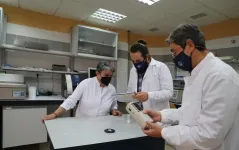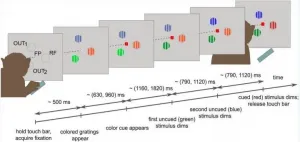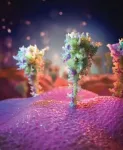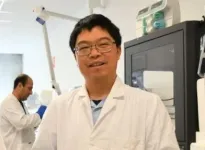INFORMATION:
The science of turning milk into cheese
2021-04-07
(Press-News.org) The global production of sheep's milk is one the rise, in the vast majority of cases used to produce cheese. However, a relatively large amount of milk is needed to produce it, so science is looking for ways to increase its yield; that is, to obtain more cheese using less milk.
Immersed in this task, a team from the Department of Animal Production at the University of Cordoba, led by Professor Ana Garzón, has collaborated with the University of Leon in the search for genetic parameters affecting the cheese production of milk from Churra sheep, one of the oldest and most rustic breeds on the Iberian Peninsula.
After analysing traits related to rennet and milk properties (pH, milk yield, fat and protein content) in a sample of more than 1,000 sheep, the research team found a low to moderate heritability of these traits, suggesting that their improvement can be achieved through genetic selection. In addition, the need to consider milk pH at the beginning of the coagulation process as a characteristic to be taken into accountas a selection index for the improvement of Churra quality was confirmed, as it will augment the 'cheesemaking capacity' of the milk from this breed.
The team,formed by Ana Garzón andthe researchers Antonio Figueroa and Javier Caballero-Villalobos, comprise the Dairy Laboratory, where the milk samples of this work were analysed, measuring their pH; the physical-chemical parameters of the milk, such as its proteins, fats, and lactose; and technological parameters, such as coagulation time and curd hardening speed; with the aim of providing information for the selection of values to be included in the genetic selection scheme of the Churra breed in order to obtain ewes that give milk with a higher yield in terms of cheese production.
The UCO Dairy Laboratory | The science that cares for milk
This service, part of the UCO's Department of Animal Production, has been working since 2003 on the study of the composition, quality and technological parameters of ruminant milk with the aim of transferring knowledge to the livestock sector to improve milk quality, productivity and yields.
The Dairy Laboratory specialises in the study of the Manchega breed, which is the most important class of sheep in terms of product quality and economic weight in the sector. In this regard, the search for a faster, cheaper and more efficient method to measure the quality of milk according to its composition is one of their main lines of research, as they are trying to determine whether chromaticity can provide information sufficient for the livestock sector to evaluate milk quickly and cheaply.
They are also striving to solve the problem of water retention in curd, which reduces the milk'syield, thus requiring a lot of milk to obtain cheese. In their latest work, they develop mathematical models to achieve more efficient milk for cheese production. Finally, they analyse the correlation between the health of the sheep's udder and these coagulation parameters of the milk slated for cheese production.
In short, this work directly transfers the science carried out in the Laboratory to the livestock sector, which benefits from improvements in the quality and efficiency of its dairy farms.
ELSE PRESS RELEASES FROM THIS DATE:
Using AI to diagnose neurological diseases based on motor impairment
2021-04-07
The way we move says a lot about the state of our brain. While normal motor behaviour points to a healthy brain function, deviations can indicate impairments owing to neurological diseases. The observation and evaluation of movement patterns is therefore part of basic research, and is likewise one of the most important instruments for non-invasive diagnostics in clinical applications. Under the leadership of computer scientist Prof. Dr Björn Ommer and in collaboration with researchers from Switzerland, a new computer-based approach in this context has been developed at Heidelberg University. As studies inter alia with human test persons have shown, this approach enables the fully automatic ...
Digital twin can protect physical systems and train new users
2021-04-07
It is more complicated than copy and paste, but digital twins could be way of future manufacturing according to researchers from the University of Kentucky. They developed a virtual environment based on human-robot interactions that can mirror the physical set up of a welder and their project. Called a digital twin, the prototype has implications for evolving manufacturing systems and training novice welders. They published their work in the IEEE/CAA Journal of Automatica Sinica (Volume 8, Issue 2, February 2021).
"This human-robot interaction working style helps to enhance the human users' operational productivity and ...
The structure and function of cortical brain cells modulated by attention
2021-04-07
To effectively perform any daily task, the human brain needs to process information from the outside world using various cognitive functions. This cognitive processing passes through a dense interconnected network of cells whose physiology is specialized. The interconnected cell network needs to perform this processing of information efficiently and interact cooperatively to provide us, in real time, with useful instructions for living.
Research published on 23 March in the journal Proceedings of the National Academy of Sciences of the United States of America challenges recent scientific advances seeking to find out how cognitive control and sensory information relate to the cortical machinery ...
First images of cells exposed to COVID-19 vaccine reveal native-like Coronavirus spikes
2021-04-07
New research has for the first time compared images of the protein spikes that develop on the surface of cells exposed to the Oxford-AstraZeneca vaccine to the protein spike of the SARS-CoV-19 coronavirus. The images show that the spikes are highly similar to those of the virus and support the modified adenovirus used in the vaccine as a leading platform to combat COVID-19.
The SARS-CoV-2 virus, which causes COVID-19, has a large number of spikes sticking out of its surface that it uses to attach to, and enter, cells in the human body. These spikes are coated in sugars, known as ...
'Patchwork' tumors prevalent across multiple cancer types
2021-04-07
Researchers at the Francis Crick Institute, as part of an international collaboration of scientists through the Pan-Cancer Analysis of Whole Genomes Consortium, have analysed the whole genomes of tumour samples from over 2,600 patients with different types of cancer. They identified a high prevalence of genetic diversity within individual tumours, which they further characterised. Their findings confirm that, even at late stages of development, tumour evolution is driven by changes that benefit the cancer.
When cancer cells divide, errors occur in the process of copying their DNA. These copying errors mean that different tumours can be made up of cells presenting a wide range of genetic diversity. This variation is a challenge for doctors as a treatment that ...
The opportunities and risks of digitalization for sustainable development
2021-04-07
Digitalisation can support transitions towards a more sustainable society if technologies and processes are designed in line with suitable criteria. This requires a systemic focus on the risks and benefits of digital technologies across the three dimensions of sustainable development: the environment, society, and the economy. This is the conclusion of a study prepared by a team of researchers at the Institute for Advanced Sustainability Studies (IASS) in Potsdam. Applying this precautionary approach to digitalisation requires the active involvement of developers, users, and regulators.
Digitalisation ...
Manual workers face twice the risk of developing ALS
2021-04-07
ALS is a progressive neurological disease that attacks the nerves that interact with the body's muscles. The disease typically leads to complete paralysis of the body, robbing patients of their ability to walk, speak, eat and breathe.
Researchers studied ALS patients and healthy elderly volunteers living in Malta who took part in an ongoing study aiming at identifying genetic and environmental risk factors. Malta is a sovereign microstate in the middle of the Mediterranean Sea, and is home to a geographically and culturally isolated population. Recently, Maltese ALS patients were found to have a unique genetic makeup compared to ...
Foetus in bishop's coffin was probably his grandson
2021-04-07
Bishop Peder Winstrup died in 1679, and is one of the most well-preserved human bodies from the 1600s. Researchers at Lund University in Sweden may now have solved the mystery of why a foetus was hidden in his coffin in Lund Cathedral. DNA from the bishop and the foetus, along with kinship analyses, has shown that the child was probably the bishop's own grandson.
Something is protruding between Bishop Peder Winstrup's two calves. The X-ray reveals small bones. Could it be an animal? When the image is studied more closely, the osteologists from Lund University can see faint signs of what is to become ...
Visionary bone damage study
2021-04-07
A novel way to pinpoint and illuminate bone damage promises to make X-rays more efficient at diagnosing bone and other injuries, Flinders University researchers say.
The new technique, looking at potential biomedical applications of an ancient inorganic salt-based aggregation induced emission (AIE) radio-luminescence material, could open new frontiers in medicine including X-ray dosimetry, bioimaging and advanced applications such as optogenetics, says Professor Youhong Tang, from Flinders University's College of Science and Engineering.
The review article, published by Professor Tang, postdoctoral student Dr Javad Tavokoli, colleagues in Hong Kong and Australian technology company Micro-X and, examined the potential of the AIEgen luminogens ...
Estimating costs of uterine transplantation
2021-04-07
Sweden's acclaimed research on uterine transplants has taken a new step forward: into the field of health economics. Now, for the first time, there is a scientifically based estimate of how much implementing the treatment costs.
The current research is based on the nine uterine transplants from living donors carried out in 2013, under the leadership of Mats Brännström, Professor of Obstetrics and Gynecology at Sahlgrenska Academy, University of Gothenburg, and Chief Physician at Sahlgrenska University Hospital.
The transplants were performed within the scope of the world's first systematic, scientifically based study in the field. After ...





